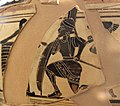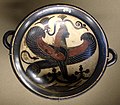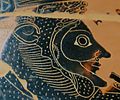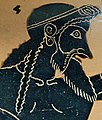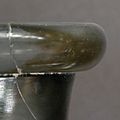Category:Louvre Museum - Room 653
Jump to navigation
Jump to search
Selon la nouvelle numérotation des salles du musée du Louvre.
room in the Louvre | |||||
| Upload media | |||||
| Instance of | |||||
|---|---|---|---|---|---|
| Room number |
| ||||
| Location | Sully Wing, Louvre Palace, 1st arrondissement of Paris, Paris Centre, Paris, Grand Paris, France | ||||
| Has use | |||||
| Occupant |
| ||||
| |||||
Français : Parcours chronologique dédié à la céramique grecque, commençant salle 655, finissant salle 651
English: Greek pottery : chronological display, starting room 655, ending room 651
Français : La diffusion de la technique à figurines noires dans le monde grec (6e siècle av. J.-C.).
English: Diffusion of the Black-Figure Technique in the Greek World (6th century BC).
Subcategories
This category has the following 14 subcategories, out of 14 total.
C
- Cup boats - Louvre F 123 (2 F)
E
L
- Louvre E 669 (4 F)
- Louvre E 701 (8 F)
- Louvre E 801 (2 F)
- Louvre E 812 (2 F)
- Louvre F 30 (5 F)
- Louvre F 32 (3 F)
- Louvre F 340 (4 F)
- Louvre F290 (2 F)
P
- Ploughman Louvre F77 (2 F)
S
- Skyphos Rayet (2 F)
W
- Woman swing Louvre F60 (3 F)
Œ
- Œnochoé (F 341) (2 F)
Media in category "Louvre Museum - Room 653"
The following 88 files are in this category, out of 88 total.
-
Charlemagne receiving Alcuin who shows to him the manuscripts written by his monks.jpg 2,025 × 2,699; 1.34 MB
-
Greek antiquities in the Louvre - Room 42 D201903.jpg 2,816 × 2,112; 1.69 MB
-
Aineias Ankhises Louvre F118.jpg 2,073 × 1,695; 1.84 MB
-
Aineias Ankhises Louvre F122.jpg 1,744 × 2,160; 1.48 MB
-
Ajax body Achilles Louvre F201.jpg 1,600 × 1,066; 1.14 MB
-
Akhilleus Louvre E662.jpg 2,091 × 1,854; 2.08 MB
-
Amphora Louvre F12.jpg 1,925 × 2,570; 2.82 MB
-
Amphora Poseidon Polybotes Louvre F226.jpg 2,300 × 3,450; 3.39 MB
-
Amphora warrior departure Louvre F12.jpg 2,260 × 1,700; 2.46 MB
-
Amphore d'Exékias - Musée du Louvre AGER MNC 495.jpg 2,328 × 3,561; 2.11 MB
-
Apotheosis of Herakles Louvre F294.jpg 2,400 × 3,200; 3.42 MB
-
Arming warrior Louvre E813.jpg 1,592 × 2,380; 2.19 MB
-
Aryballos Kameiros Louvre A486.jpg 1,300 × 1,300; 965 KB
-
Band cup Louvre F72.jpg 3,200 × 2,210; 3.96 MB
-
Band cup Louvre F75.jpg 2,400 × 1,400; 1.95 MB
-
Calydonian hunt Louvre E670.jpg 1,800 × 1,600; 1.88 MB
-
Column crater Louvre E677.jpg 2,100 × 1,800; 2.4 MB
-
Coupe à lèvre attique à figures noires - Musée du Louvre AGER LP 2315 ; N 3257 ; F 87.jpg 3,457 × 2,438; 1.87 MB
-
Cup Sphinx Louvre E664.jpg 1,980 × 1,726; 2.09 MB
-
Detail E Group Louvre F53.jpg 1,375 × 1,145; 1.04 MB
-
Detail E Group Louvre F55.jpg 650 × 720; 347 KB
-
Detail from Judgement of Paris Louvre F31 cropped-white balanced.png 1,364 × 1,072; 3.03 MB
-
Detail Swing Painter Louvre F60.jpg 1,000 × 1,000; 665 KB
-
Detail Taleides Painter Louvre F340.jpg 800 × 940; 587 KB
-
Dinos animals Louvre Cp11243.jpg 2,200 × 1,920; 2.61 MB
-
Dish siren Louvre MNB626.jpg 1,935 × 1,890; 2.5 MB
-
Dish Thetis Peleus Louvre CA2569.jpg 2,400 × 2,400; 4.34 MB
-
Droop cup Louvre CA2512.jpg 2,625 × 1,400; 1.77 MB
-
Gorgon Louvre F230.jpg 2,750 × 2,300; 3.41 MB
-
Heracles Geryon Louvre F55.jpg 2,200 × 1,830; 2.81 MB
-
Herakles Eurystheus boar Louvre F202.jpg 1,605 × 1,362; 1.25 MB
-
Herakles Kyknos Louvre F36.jpg 2,181 × 1,656; 2.09 MB
-
Herakles lion Louvre CA1340.jpg 1,770 × 2,756; 2.4 MB
-
Herakles lion Louvre F107.jpg 2,760 × 1,584; 2.05 MB
-
Herakles lion Louvre F33.jpg 2,283 × 1,809; 2.21 MB
-
Herakles Pholos Louvre E662.jpg 2,028 × 1,636; 1.6 MB
-
Herakles Prometheus Louvre MNE1309.jpg 2,160 × 1,777; 1.75 MB
-
Hermes kriophoros Louvre F159.jpg 2,300 × 3,450; 3.28 MB
-
Hermogenes skyphos Louvre S1836.jpg 2,400 × 1,500; 1.74 MB
-
Hoplites fight Louvre E735.jpg 3,008 × 2,000; 4.21 MB
-
Hydria Herakles Triton Louvre F51.jpg 2,500 × 3,125; 3.42 MB
-
Hydria Louvre F43.jpg 1,990 × 2,400; 2.97 MB
-
Hydria warrior departure Louvre E804.jpg 2,700 × 1,900; 3.22 MB
-
Hydrie avec décor de centauromachie - Musée du Louvre AGER Cp 64 ; E 700.jpg 3,024 × 3,915; 3.79 MB
-
Judgement of Paris Louvre F31.jpg 2,463 × 1,830; 2.59 MB
-
Kadmos dragon Louvre E707 (enhanced).jpg 2,396 × 1,791; 477 KB
-
Kadmos dragon Louvre E707 full.jpg 1,920 × 2,748; 2.12 MB
-
Kadmos dragon Louvre E707.jpg 2,460 × 1,791; 2.45 MB
-
Kantharos sphinxes Louvre CA1339.jpg 2,120 × 1,700; 2 MB
-
Kantharos symposion Louvre MNE1172.jpg 2,396 × 1,932; 2.61 MB
-
Kassel cup Louvre E673.jpg 2,500 × 1,670; 2.02 MB
-
Kyathos Dionysos Louvre CA3309.jpg 1,710 × 2,000; 1.79 MB
-
Lekythos Louvre E718.jpg 1,600 × 2,125; 1.89 MB
-
Neck amphora animals Louvre E796.jpg 1,900 × 2,525; 2.73 MB
-
Neck amphora Dionysos Louvre F36bis.jpg 1,850 × 2,800; 2.81 MB
-
Nikosthenic amphora Louvre F111.jpg 1,750 × 2,650; 2.9 MB
-
Nikosthenic amphora Louvre F99 cropped glare reduced white bg.png 946 × 509; 899 KB
-
Nikosthenic amphora Louvre F99.jpg 1,720 × 2,300; 2.19 MB
-
Odysseus Ajax Louvre F340.jpg 1,680 × 1,525; 1.78 MB
-
Oinochoe Odysseus Ajax Louvre F340 glare reduced.png 2,100 × 2,897; 6.35 MB
-
Pederastic courtship Louvre F20.jpg 2,250 × 3,400; 4.56 MB
-
Pederastic courtship Louvre F43.jpg 3,075 × 2,120; 4.4 MB
-
Pederastic courtship Louvre F51 n2.jpg 1,680 × 2,250; 2.52 MB
-
Pederastic courtship Louvre F51.jpg 2,030 × 2,530; 3.21 MB
-
Ploughman Louvre F77.jpg 1,975 × 700; 1.63 MB
-
Poseidon Polybotes Louvre F226.jpg 1,920 × 1,930; 2.78 MB
-
Riders Leagros Group Louvre CA4716 n2.jpg 3,000 × 2,400; 3.78 MB
-
Riders Leagros Group Louvre CA4716.jpg 3,200 × 2,406; 3.01 MB
-
Siana cup Louvre F67.jpg 2,700 × 1,500; 2.1 MB
-
Signature Exekias Louvre F53.jpg 1,600 × 600; 563 KB
-
Signature Nikosthenes F102.jpg 2,675 × 1,780; 3.16 MB
-
Signature Nikosthenes F105.jpg 2,100 × 1,400; 2.11 MB
-
Strainer vase Herakles Louvre CA822.jpg 1,960 × 2,950; 4.22 MB
-
Theseus Minotaur Louvre F33 n2.jpg 1,800 × 2,400; 2.98 MB
-
Theseus Minotaur Louvre F33 n3.jpg 5,000 × 4,000; 9.44 MB
-
Theseus Minotaur Louvre F33.jpg 2,650 × 2,200; 4.14 MB
-
Torus lip Louvre F22.jpg 1,300 × 1,300; 1 MB
-
Troilos Polyxene Louvre E662.jpg 2,937 × 1,815; 2.82 MB
-
Warrior departure Louvre E804.jpg 2,450 × 2,890; 4.46 MB
-
Warrior departure Louvre F22.jpg 2,223 × 3,223; 1.67 MB
-
Warrior departure Louvre F27.jpg 2,100 × 3,160; 3.99 MB
-
Warrior youths Louvre F26.jpg 2,100 × 3,200; 3.94 MB
-
Woman plemochoe Louvre L110.jpg 1,950 × 3,575; 3.39 MB
-
Zeus Naucratis Painter Louvre E668.jpg 2,264 × 1,914; 2.32 MB






